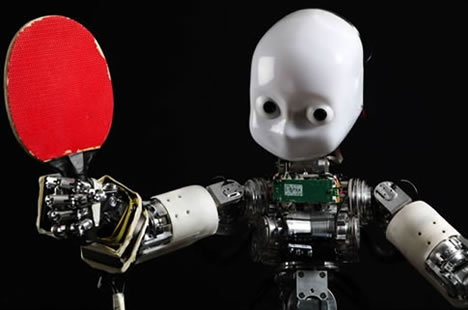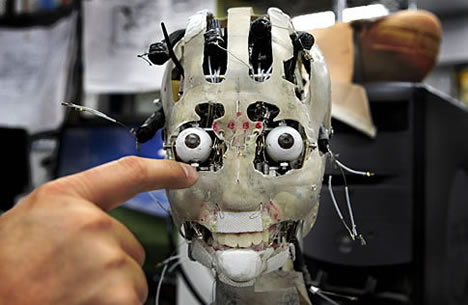If you think today’s robots look closer to toasters, vacuum cleaners, or other appliances, then you better sit down. Have you wondered why we don’t have robots like Number Six, Data, C-3PO, or Rosie? But we do have them, some are close. There is more happening on the robot scene than most of the population realizes. Some robots are very good company. Scoff if you must, but with a dash of humor, two pinches of sarcasm, a slice of conspiracy, and a large dose of robotic reality, this is how Skynet really starts.
Robotic Advancement – Population Explosion
(image credits: bigpicture,wired,Technology Review,slipstersblog,Pink Tentacle,cnet)
The robot population has surged to nearly 9 million! Most of us are used to Disney type animatronics, so it’s not too shocking to see robots synchronized and performing with swords. We have carnivorous robots, but not too many screamed blood sucking start of Skynet. On the military front, robotics have taken a huge leap forward such as unmanned vehicles, drone planes, robotic soldiers like Big Dog, semi-autonomous killing machines, and even possible robot medics on the battlefield. Robots work in factories and work as surgeons in hospitals. Designers have tried to make robots appear friendlier, move smoother, become smarter, working to overcome human reluctance to interact with robots. Robots are supposed to make us safer, to do the dangerous work, to make our lives easier. What’s not to love about it? Remember Skynet?
Giant Baby
(image credits: designboom,ieee spectrum,Big Picture,yahoo)
Babies are cute and harmless, right? Babies strike an instinctive chord in us, lower our guards and lull us into feeling as if we are in charge of caring for them. What an excellent place to start whittling away at human reluctance to interact with robots. On the other side of the argument, baby and child robots are that much more creepy. The Yotaro Baby Simulator is an interactive robot to teach children who are about to become a big brother or sister about baby siblings. It even cries “real” robot tears. Reborn Babies look real enough to fool some people. Then there’s the huge animated baby mannequin displayed at the World Expo 2010 in Shanghai. Why is there a need to anthropomorphize robots; can’t robots look like robots? But then . . . how exactly do robots look?
iCub
(image credits: ieee spectrum)
iCub, the open-source Robot Child, is a humanoid robot the size of a 3-1/2-year old child. In the top photo, iCub is flashing the peace sign. However, what’s going on in that little metal mind? iCub walks, crawls, does most things a toddler can do. What if his software evolves to artificial intelligence? He might just as happily bash you in the head with a ping pong paddle or worse? Is iCub impressive or chilling?
What could go wrong?
(image credits: spectrum,sodahead,oh gizmo)
What could possibly go wrong when we arm and allow unmanned war vehicles and soldiers, or put potential weapons within their robotic reach? How about robots linking to our computers? We handed them systems and potential deadly weapons like knives for robot cooks. Fire breathing robots of destruction, will that be how it begins? Could the robot with the doll head and handling a screwdriver make the jump to AI and Chucky? Never fear for that is not how Skynet really starts . . . although Scientists Worry Machines May Outsmart Man.
Robots Showing Emotions Like Human Beings
(image credits: Daily Mail,gizmowatch,boston.comBig Picture)
Humanoid androids are designed to appear male or female. Jerky movements give them away as much as how unrealistically human they look. Yet robots have learned to mock our facial expressions. If a robot empathizes with you, would you tend to like it better? Synthetic faces are light and easy to move, easy to produce, easy to show human expressions and therefore overcome the hurdle in human-robot interactions.
Diego San
(image credits: botjunkie)
Diego-San is a sophisticated humanoid robot modeled after a 1-year-old child. He is designed to discover how babies acquire and refine the ability to use nonverbal communication such as gestures and facial expressions. All that is needed after that will be a more welcoming synthetic face or synthetic body. Then he’s ready to be shipped off to Cyberdyne Systems where he can be sold, and then infiltrate childless couples’ homes in a neighborhood near you. That still should not shake you up, perhaps creep you out, but not to worry. That is not how Skynet really starts. Is he hugging the child like a proud papa . . . or? Never mind that chilling thought. Besides, scientists haven’t successfully developed AI yet, right? Wrong.
CB2
(image credits: boston)
Bald little CB2, Child-robot with Biomimetic Body, with his soft silicone skin and four-foot, four-inch body is an “infant.” His designers claim CB2 interacts with humans and watches their facial expressions, mimicking a mother-baby relationship. Furthermore, his creator expects science to advance to a “robo species” with advanced learning abilities. What then when they make these creatures more human-looking? We’ve seen the synthetic skin, expressive faces, and robots with artificial intelligence and acting on their own.
Hiroshi Ishiguro
(image credits: ieee spectrum,ieee spectrum)
Japanese roboticist Hiroshi Ishiguro created his twin to make robots look and act more like human beings. The android, Geminoid HI-1, blinks, twitches, talks with the same intonations, all but walks as if it were a copy of Ishiguro. In fact, Ishiguro wants to make robots human-looking enough to be the natural interface for humans. He believes we could come to accept humanoids the more we are exposed to them in the future, learning to “rely on them for our care and other needs.” He intends to make androids so lifelike and “human” that they are able to hurdle over the chasm of the uncanny valley.
Female Geminoid
(image credits: ieee spectrum)
The robotic clone of a twenty-year-old woman, Geminoid F, is the newest female android created by roboticist Hiroshi Ishiguro. She looks fairly natural when striking a smile or a frown. You might forget she looks a bit like a terminator under her synthetic skin. Ishiguro learned much about human-robot interaction when his 4-year-old daughter burst into tears after meeting his master template and her replica, Repliee R1. Interestingly enough, like something out of The Matrix or Avatar, Ishiguro discovered that simply touching the android is enough to trigger the same exact physical sensation for the operator. It is like the operator’s brain behaves almost as though he were inhabiting the robot’s body.
Robotic Women
(image credits: ieee spectrum,dailymail,Pink Tentacle,Big Picture)
Yes, we are going to go there. Why make them attractive women? Actroids, androids, humanoids, these female robots can mimic facial expressions enough to work in a demonstration booth, as a receptionist, or dress to appear like a beauty pageant queen. All of these women robots drew a crowd to admire them, to interact with them. If they can walk this way and talk this way, could you jump past the uncanny valley? Robotic women, why else try to make them “attractive” and “appealing” if not headed for the inevitable?
Miim . . . Here comes the robot bride
(image credits: ninemsn)
The HRP-4C humanoid robot Miim walked down the catwalk, modeling a wedding gown. Miim then told the stunned audience how happy she was to be wearing the dress. Robots breaking into the modeling, fashion, and entertainment industry? It’s happening right now. Women in those lines of work are generally swamped with admirers and wanna-be dates. Now here’s a female robot dressed for marriage, straight out of predicted research about intimate relationships with artificial partners and Sex and Marriage with Robots by 2050. But wait, we’re not actually there yet. Where humans care for robots and robots care for humans?
Japan Teacher Robot
(image credits: gizmodo,smh,crunchgear)
This is Saya. Let’s hope she doesn’t get ticked at the roboticist peeling off her face and poking her in the eye . . . but a robot uprising is not how Skynet will start. Saya is taking care of and (terrifying) teaching elementary school children in Japan. Yes, creepy, robots are caring for humans.
SimMan 3G Patient Simulator
(image credits: medgadget)
The SimMan 3G Patient Simulator can cry, bleed, convulse, go into cardiac arrest, and have all sorts of medical conditions. Robots learn to care for us like Saya and we are learning to take care of robots. The caring, the sharing, that intimacy which develops as a result of caring and sharing is approaching the point of no return.
Robot Birth…Will that be natural or C-section?
(image credits: uberreview,classroomrobotics)
What if robots were advanced to the point of birthing children? Will that be natural or C-section delivery? And the baby robots who cry and burp, being nursed and helping teach medical students and future parents more about childcare? If an emotional attachment develops, would a human cry if the robot baby dies? At least we haven’t figured out how to use robots as surrogate mothers. Thank goodness robots don’t know how to reproduce yet . . . oh wait!
Robots Kissing
(image credits: cnet)
Oh yes, try not to shudder, but robots kissing was an “accomplishment” in 2009. This robo-erotica was part of a production of “Phantom of the Opera” in Taiwan. Could there be benefits perhaps if some lonely soul found comfort in robotic arms? Forget ethics for a minute. Would it be bad if anatomically correct robots with artificial intelligence and flawless, flesh-like synthetic skin were there to offer solace? It’s been argued that kiddie molesters could be turned loose on some hapless robot child to keep human children safe. This type of thinking should either make you puke, horrified, or angry.
Meet Roxxxy
(image credit: Huffington Post)
There are always people who think it, but some are brave enough to post the question. They must not have known the answer. Oh yes you can and her name is Roxxxy. “She can’t vacuum, she can’t cook but she can do almost anything else if you know what I mean,” Douglas Hines, the president of ROXXXY manufacturer TrueCompanion, told the AFP. “She’s a companion. She has a personality. She hears you. She listens to you. She speaks. She feels your touch. She goes to sleep. We are trying to replicate a personality of a person.”
Can it get any more strange? Oh yes, for this is how Skynet starts.
Married to a Robot
(image credits: ieee spectrum,geeky-gadgets)
Caring about robots to the nth degree is inventor Le Trung. He has a robot wife with real silicone skin and a human hair wig. In fact, he loves his fembot wife Aiko in more ways than you probably would care to know. He designed her body to be touch sensitive and to understand the difference between being tickled or gently stroked. She also has slapped an individual who touched or squeezed her too hard. Aiko has advanced artificial intelligence, recognizes faces, and speaks two languages – English and Japanese. He’s probably safe since she can’t yet walk and he can’t send her to the kitchen to get him a sandwich. Besides, an uprising and violence is not how it begins. Sex is how skynet will start. Oh wait, we’ve seen a couple examples now of human-robot intimate relations. Sex is how Skynet started.
Japanese Man Marries Virtual Girlfriend
(image credits: telegraph)
You might love your software/hardware, but would you marry it? A man in Japan married his virtual girlfriend. His bride, Nene Anegasaki, is a character from a dating-simulation game for the Nintendo DS called Love Plus. The virtual girl’s in-game best friend even attended the wedding and gave a speech.
Robot Love
(image credits: futureconverged)
Robot love is happening even now, but not quite like this. This is the future, our future. This is how Skynet starts.
So again . . . What could go wrong?
(image credits: battlestarwiki,cyberpunkreview, fupaper,wired)
Cylons and terminators may yet come to Cyberdyne or Earth, but that is not how Skynet will begin.
Sex . . . is how skynet really starts
(image credits: metro)
The answer is sex. Oh yes, you can be sure, this is how Skynet starts.






































